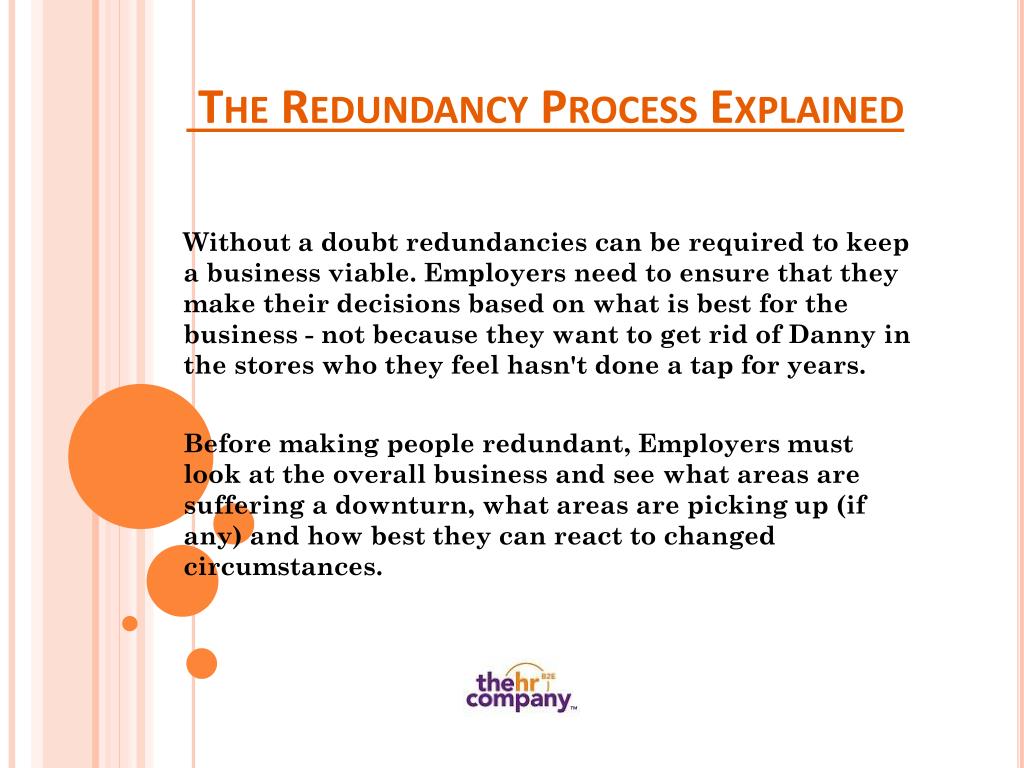Small Business Closing Employee Rights UK: Guaranteeing Fair Redundancy Pay
Wiki Article
Exploring the Operational Dynamics of Company Redundancy and Its Long-Term Sustainability

Redundancy Techniques for Company Connection
In order to ensure nonstop operations, services have to apply efficient redundancy techniques for organization continuity. Redundancy in this context describes the replication of essential parts or functions within a system to reduce the effect of potential failings. By including redundancy approaches, companies can enhance their strength against interruptions caused by numerous factors such as all-natural catastrophes, tools failings, or cyber-attacks.
One common redundancy approach is the execution of backup systems and information storage solutions. This involves creating matches of necessary information and systems that can be turned on in situation of a primary system failure. Furthermore, companies can develop redundant communication networks and source of power to preserve connectivity and operations throughout unanticipated events.
In addition, cross-training staff members to execute several roles within the business can serve as a valuable redundancy technique. If vital employees are not available due to health problem or various other reasons, this makes sure that crucial tasks can still be carried out also. In general, reliable redundancy techniques are important for companies to support functional continuity and lessen the impact of prospective interruptions.
Effect of Redundancy on Business Strength
Offered the critical function redundancy approaches play in ensuring service continuity, exploring the influence of redundancy on business durability becomes necessary for comprehending the holistic operational characteristics of a firm. Business durability refers to an entity's ability to adapt to disturbances, recover from obstacles, and transform when necessary while keeping core functions. Redundancy, when purposefully applied, can significantly add to improving a company's resilience when faced with unexpected obstacles. By having back-up systems, workers, or processes in position, business can much better endure shocks and continue procedures with minimal interruption.Furthermore, redundancy can foster technology and creativity within a company as workers feel empowered to take calculated dangers, recognizing that there is a safety and security web to support them in instance of failing. In general, the impact of redundancy on business resilience is profound, forming the lasting sustainability and success of a company.
Balancing Efficiency and Flexibility in Redundancy
Accomplishing a harmonious balance in between functional efficiency and flexible versatility is a critical challenge in the critical deployment of redundancy within organizations. Efficient procedures are important for maintaining efficiency and cost-effectiveness, ensuring that sources are made use of optimally. Nevertheless, excessive focus on performance alone can lead to rigidness, making it hard for companies to adjust to unexpected changes or challenges. On the other hand, versatility allows companies to respond nimbly to advancing circumstances, cultivating advancement and resilience. Yet, way too much versatility without a strong functional foundation can cause inadequacies and incongruity.To stabilize effectiveness and adaptability in redundancy preparation, companies must very carefully assess their operational requirements, market characteristics, and calculated objectives. Carrying out lean practices can boost efficiency by getting rid of and streamlining procedures waste, while fostering a society of flexibility and continual improvement can improve flexibility. Furthermore, investing in cross-training programs and robust communication channels can aid cultivate a versatile workforce with the ability of taking care of varied jobs during periods of change. Inevitably, locating the ideal stability in between efficiency and flexibility is crucial for building a lasting and resilient company when faced with uncertainty.
Long-Term Sustainability Via Redundancy Preparation
To ensure enduring feasibility and security, companies need to strategically straighten their redundancy planning with long-lasting sustainability goals, thereby integrating operational effectiveness with flexible versatility. Companies need to see redundancy not as a reactive solution to prompt problems yet as a proactive method for long-term success.
Proactive Measures for Sustainable Business Workflow
Exactly how can firms proactively improve their operational sustainability for long-lasting success? Executing proactive actions is essential for companies aiming to ensure lasting procedures. One key method is to spend in modern technology and innovation to simplify procedures, reduce waste, and stay competitive in the market. Adopting lasting practices such as decreasing energy intake, decreasing carbon footprint, and maximizing source utilization can not only benefit the setting however also lead to cost financial savings over time.Moreover, cultivating a society of continuous enhancement and learning within the organization can improve versatility to changing market conditions and customer needs. Urging staff member participation in decision-making procedures and giving possibilities for professional development can boost spirits, efficiency, and overall performance. Establishing clear objectives, keeping an eye on crucial efficiency signs, and regularly examining development are vital elements of proactive sustainability management.
Teaming up with distributors, consumers, and various other stakeholders to promote sustainable practices throughout the supply chain can create a causal sequence of positive effect - redundancy pay if company goes bust. By taking positive actions in the direction of functional sustainability, companies can build resilience, drive advancement, and secure their long-term success in an ever-evolving business landscape
Conclusion

In the realm of organizational administration, the strategic implementation of firm redundancy stands as a critical yet intricate method that requires a fragile balance in between operational performance and long-term stability. By studying the functional dynamics that underpin company redundancy and examining its broader effects for organizational strength and adaptability, a nuanced understanding of just how redundancy methods can shape the future trajectory of a business begins to unravel.Offered the vital duty redundancy strategies play in ensuring organization continuity, discovering the influence of redundancy on organizational strength becomes necessary for comprehending the alternative operational dynamics of a company. On the whole, the impact of redundancy on organizational durability is profound, shaping the lasting sustainability and success of a company.
In verdict, understanding the operational characteristics of firm redundancy is essential for making certain lasting who pays redundancy money sustainability.
Report this wiki page